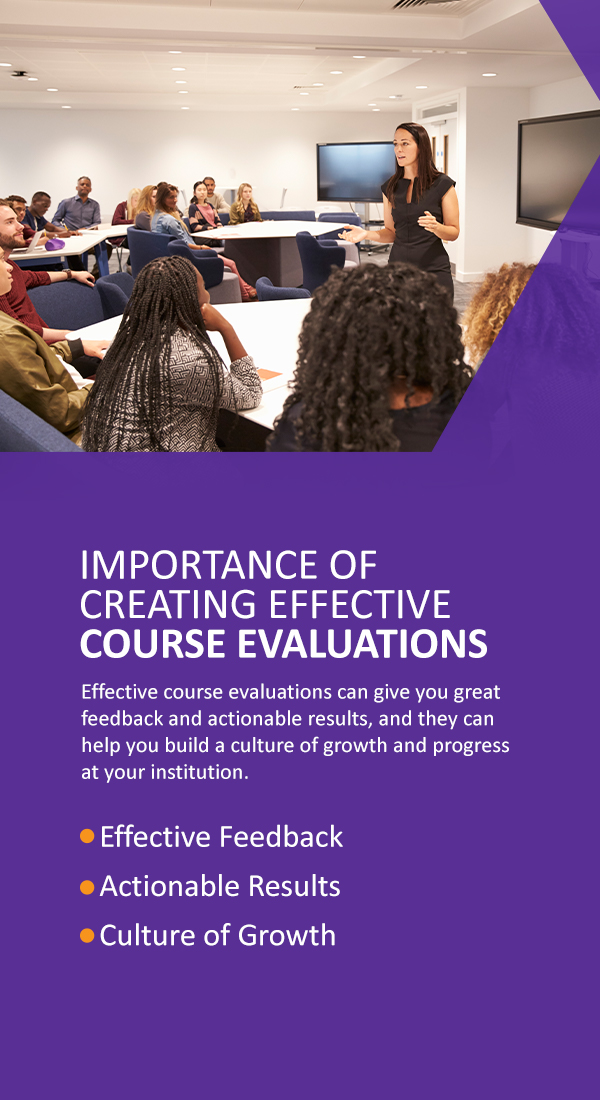




A course evaluation can be very beneficial. It can give effective feedback to make your institution function better and help foster an environment of progress and continuous learning. However, evaluations are often done incorrectly — they include questions that are too general, are overly long, or don’t have a clear goal. Evaluations face many of these problems, and it can be challenging to craft an effective course evaluation. With this guide, you can take the necessary steps to build an actionable and effective university course evaluation.
From starting with a goal to determining how you’ll distribute your evaluation, there is a lot to keep in mind as you build your student course evaluations. Course evaluation templates, examples, and samples can be helpful, but you need to sort out what you need and what you don’t.
It helps to break down the process into pieces and focus on each one as you go. Here are 10 steps that show you how to create a course evaluation.
One of the most important things you can do when building a course evaluation survey is identify a goal. Many times, people will start with a course evaluation without really thinking about the intention. Without this intention, the assessment loses its focus and value. The questions will stray off course because there’s no central theme in mind, and even those taking the evaluation may feel like there’s no value in filling it out.
Be as specific as you can with your goal — a narrow, tailored goal will make your questions more pointed and elicit more actionable feedback. Are you focusing on the materials of the course? Wondering how well students are grasping the subject matter? Pick one of these specific topics and keep it in mind throughout the entire process.
Whenever you feel you’re beginning to stray from that central theme, you can always fall back on your goal. It will give you a center point around which everything else can revolve.

After you’ve identified a goal, you should target each question of your evaluation around it. If your goal is to determine how well students understand the subject matter, for instance, then each question should strive to answer this. You might find that having a tailored goal will provide you with fewer questions, as each specified question will bring more value. This gives you the added benefit of shortening your evaluation while still gathering valuable information.
Narrowing down your focus to a specific goal will make it easier to build your evaluation. You can put some walls around the number of questions you’ll ask so you’re not just choosing questions out of thin air. Instead, you will craft each one with a specific end goal in mind. You can have more confidence in the effectiveness of your evaluation, and those taking it will feel they’re contributing to something with real value, as well.
Be sure to communicate your goal to those taking the evaluation. It helps to have a goal in mind as you build the evaluation, but it’s also beneficial for those taking it to understand the purpose of your questions. Consider including the goal or the intent at the top of the class evaluation form. If you’ve designed the assessment to test the accuracy or effectiveness of class materials, for instance, then communicate this somewhere in the survey.
Communicating your goal offers different benefits:
Communicate your goal clearly and succinctly, and you’ll help your evaluators as well as yourself.
It’s essential to be as clear as you can in your evaluation. Wandering and general questions are harder to answer and are also less effective. If participants can’t understand what your evaluation is asking, you won’t get accurate answers.
If you’re clear while crafting your evaluation, you can receive more straightforward answers. Use short, simple questions that are easy to read to ensure participant engagement and understanding.
Being clear can also relate to more than just how you phrase the questions — it also pertains to the format of the questions, the overall evaluation design, and its length. That’s a lot to keep in mind, but the benefits of simplicity and clarity can improve your evaluation dramatically in the end.

Varying question styles can add some diversity to your evaluation. Limiting your questions to one format — such as a rating scale — might close off some valuable information that could be gathered in free text, as respondents might have something specific to say on the subject. Varying question format also helps prevent survey fatigue, keeping your participants engaged through every question.
Each question format brings its advantages:
You should strive for continuity for the bulk of the evaluation, but it can help to sprinkle in a few other formats to offer some variety and diversify the answers you’ll get. People like to express their feedback in different ways, and your evaluation should reflect this.
Shorter is better. If participants see a long, drawn-out course evaluation, they may feel the time it takes to complete it outweighs its actual value. The longer your evaluation gets, the more people will start randomly answering questions for the sake of time. Therefore, try to keep your evaluation as brief as you can without sacrificing any information.
Creating a goal and structuring the student course evaluation around it will help you stay focused — you’ll be able to ask specific, pointed questions around a particular theme instead of asking general questions on a variety of different topics.
Students will likely be taking multiple course evaluations at the end of the term, making it all the more necessary for surveys to be short. To add convenience, you could even project the estimated time the evaluation will take in the introduction. Time estimates give students a way to block out the necessary time and know exactly how long the assessment should take to complete. Keep the questions tight and focused, and your evaluators will thank you.
You should also consider the design of your course evaluation. It should be easy to read, concise, and free from any jumbled or overly long paragraphs. A student will have an opinion of the evaluation as soon as they open it, which will determine whether they take it seriously or fill it out quickly to get through it.
Because students will have more than a few evaluations to fill out, you should strive to make your evaluation simple. In the introduction, outline your goal and offer clear directions, followed by your questions.
Another way to ensure you’re getting great feedback is to ask engaging questions. It’s easy to replicate the same old questions over and over, recycling them just to receive similar answers you’ve seen many times before. Asking a question that delves deep into a subject can give you excellent feedback and make the evaluator really think about how to respond. Those are the questions you want — ones that pull real, authentic answers and cause the student to reflect before answering.
For instance, you might offer an open-ended question that puts the agency in the respondents’ hands by asking them how they would improve a course’s structure. You could also ask what subjects they believe should’ve been covered in a course.
A great way to create engaging questions is to narrow down that goal at the beginning of this process. The more focus you have, the more in-depth you will be able to go with your questions, and the better your answers can be.
It’s easy to lose sight of one of the most critical parts of the evaluation process — confidentiality. It might seem like a tedious step, but communicating the discreetness of your assessment will give the evaluator confidence that their answers are protected and safe. Without confidentiality, they probably won’t answer as candidly, which in turn compromises your evaluation and makes the answers less valuable.
The whole purpose of an evaluation is to gather honest data, and without confidentiality, that entire premise is in jeopardy. It’s essential to communicate in your evaluation that answers are safe and completely anonymous. Knowing this, you can have confidence knowing the answers given are more likely to be true and accurate.
The medium you use will impact how effective your evaluation is. Paper surveys are becoming obsolete, and now, new technologies are making it easier than ever to take a course evaluation online. Digital software can let you gather information through an integrated system that makes it simple to get strong response rates, gather thorough data, and pull feedback into timely reports.
You can design a fool-proof evaluation, but without the proper medium to deliver it to respondents, the whole process could fall flat. That’s why it’s so important to find quality, trusted software that can take care of this step and ensure you’re gaining enough valuable data to keep learning and improving.

Building a course evaluation that gives you valuable, actionable data is a huge advantage. Effective course evaluations can give you great feedback and actionable results, and they can help you build a culture of growth and progress at your institution.
One of the most obvious benefits of creating an effective course evaluation is effective feedback. If you neglect a crucial step — the length of the evaluation, clarity, or confidentiality — the accuracy and authenticity of the entire survey can be compromised. But sticking to a formula and focusing on each step ensures you can get the information you need to improve.
The effort you put into the evaluation will likely reap similar results, meaning if you’re able to craft a clear, concise assessment, you’ll likely receive clear responses. You can then use these responses effectively and put them into action to redesign courses, address certain teaching styles, or make other improvements.
Some evaluations collect data that doesn’t amount to much — you can look at it and synthesize it, but it might be too general to actually use it. On the other hand, if you have a concise, targeted evaluation with a goal already in place, your survey can give you precise information you can use to spur progress and develop your faculty’s skillsets. You can use the results in a tangible way instead of just reading and gathering data for the sake of obtaining it.
Putting effort into evaluations and making sure they have real value does more than just obtain effective feedback. It shows students, faculty, and administrators that you take the growth of your instructors seriously, and you’re committed to seeing development and continual progress. Without feedback, an institution can become stagnant, buried in its old ways, and unchanging. With the right evaluations and effective, actionable feedback, you can identify points of weakness and seek to correct them.
By emphasizing the need for feedback and accurate evaluations, you will be building a culture of growth and continual progress. That’s a culture to be proud of and one that can reap many benefits in the future.

Watermark has the digital software you need to gather feedback from students. We designed Watermark Course Evaluations & Surveys for higher education to facilitate actionable data and information. With our unique, integrated system, we increase response rates, gather actionable insights, and build faculty reviews synthesized from student data.
Watermark’s software works with your existing technology to offer you access to readable, clear insights you can use to encourage progress and growth for your faculty. Request a demo today!






























































































































































































































































































































































































Submit this form to schedule a meeting with one of our reps to learn more about our solutions. If you need customer support instead, click here.